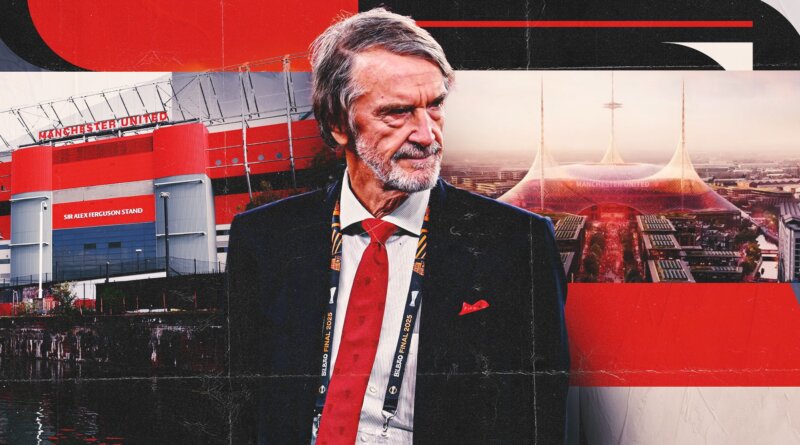Man Utd New Stadium Faces Mounting Hurdles and Delays
Manchester United new stadium plans remain in limbo as Sir Jim Ratcliffe’s ambitious vision for a “world’s greatest football stadium” faces a series of daunting obstacles. Nearly seven months after unveiling a dramatic 100,000-seater arena proposal for the Old Trafford site—with architect Norman Foster’s bold canopy design as its crown jewel—the reality has proven far more complex for United’s ownership.
Manchester United New Stadium: The Grand Vision
Manchester United new stadium project was introduced with much fanfare, promising a transformative 100,000-seat stadium set to become the “Wembley of the North.” The plans, showcased by Sir Jim Ratcliffe and acclaimed architect Norman Foster, outlined a futuristic ground enveloped in a striking canopy, intended to set new standards in sports architecture. Ratcliffe expressed excitement in March, calling it “an incredibly exciting journey” for the club and its fans.
The Land Ownership Challenge
However, significant barriers have swiftly emerged. One of the most critical issues is the fact that Manchester United does not yet own all the land required for the stadium’s footprint. Negotiations to acquire these parcels have proven more complicated and expensive than initially anticipated. Rising land values and complex ownership structures mean that the club is locked in delicate talks, threatening to derail the timetable for construction.
Financial Constraints and Rising Costs
Beyond land issues, financial hurdles loom large. The estimated £2 billion cost for the Manchester United new stadium is already under pressure due to inflation and escalating material prices. The club has not yet secured full funding for the project, and with no planning permission in place, investors are reportedly hesitant to commit substantial sums. This uncertainty has cast doubt on whether United can deliver the stadium within the celebrated five-year timeline.
Planning Permission and Design Uncertainty
The journey towards the Manchester United new stadium is also complicated by planning and design delays. Despite Norman Foster’s association with the project, there is still no confirmed architect or finalized blueprint. Local authorities have yet to grant planning permission, and community groups have raised concerns about transport links, environmental impact, and the potential loss of heritage associated with the current Old Trafford site.
Canopy Feature at Risk
Perhaps most symbolic of the project’s difficulties is the risk to its most distinctive feature: the dramatic canopy that was meant to encase the stadium. This innovative design element served as the unique selling point at launch, promising to create a landmark visible across Manchester. However, budgetary pressures and engineering challenges have placed the canopy in jeopardy of being abandoned, raising fears that the final stadium may lack the iconic touch crowning the original concept.
Timeline and the Race Against the Clock
With these roadblocks, the prospect of completing the Manchester United new stadium within five years increasingly looks unrealistic. Without land ownership, planning approval, or secured financing, every stage of development faces potential delays. The five-year promise, made in the initial promotional video, now appears highly optimistic—if not unattainable—unless a series of breakthroughs occur in short order.
Community and Heritage Concerns
Local residents and Manchester United supporters have expressed mixed emotions about the proposed changes. While many welcome a modern stadium befitting one of Europe’s biggest clubs, others fear the loss of Old Trafford’s unique character and its place in football history. There are concerns about traffic congestion, disruption to local businesses, and the challenge of integrating a futuristic structure into the fabric of the existing neighborhood.
What’s Next for the Manchester United New Stadium?
The coming months will be critical for Sir Jim Ratcliffe and the Manchester United board. Securing additional land, finalizing architectural plans, and obtaining vital permissions will determine whether the club’s dream of a world-class stadium becomes reality or remains a remote aspiration. Meanwhile, fans and the wider football world watch closely, eager to see if United can overcome these mounting hurdles.
Opinion: United Must Prioritize Legacy and Realism
Manchester United’s ambition to create an “iconic” new stadium is commendable, but the journey so far highlights the importance of balancing vision with practicality. The club would be wise to engage openly with fans and local stakeholders, ensuring that any new arena reflects United’s rich legacy while meeting the financial and logistical realities of modern football. For more news, updates on United’s stadium plans and the world of football, visit for more news.
Your global gateway to nonstop football coverage:
News Goal
Share this content:

